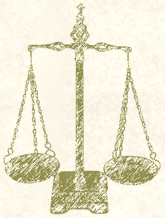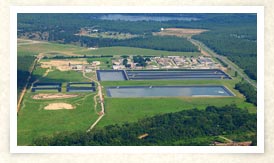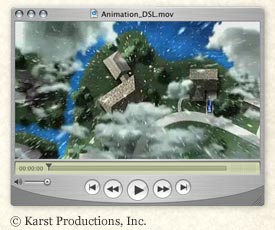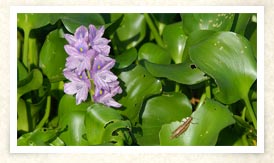"Our abilities to counter the threats need to grow as the
threats continue to increase."
threats continue to increase."
Jim Maher, scientist,
Florida Department of Environmental Protection
Florida Department of Environmental Protection

Varied though they are, the major threats to the St. Johns River fall into three distinct categories:
Many solutions exist, and some are in place, successfully countering the impacts. However, the scales are tipped, with threats far outweighing solutions. Balance is key. There needs to be a solution to counter each and every current threat, and solutions need to be waiting in the wings to meet future threats.

A wastewater treatment plant in Florida.
Point-source pollution can be traced and attributed to a particular pipe or a specific fixed location. It's possible to identify and point a finger at specific offenders. Identifiable point sources have been, and continue to be, responsible for discharging materials that affect the St. Johns; these offenders include municipal sewage treatment plants and industries such as pulp mills and electricity generating stations. Discharges range from warm water to contaminants such as bacteria, chemicals, and metals. Historically, government agencies and environmental groups have focused on reducing point-source pollution in their efforts to slow down the degradation of the St. Johns River.
The Federal Water Pollution Act of 1972 -- amended by the Clean Water Act of 1977 -- drew attention to the big industrial sources of pollution and gave the Environmental Protection Agency the right to set standards and enforce them. The Clean Water Act established three main goals:
- Elimination of polluting discharges to the nation's waters by 1985;
- The restoration and protection of water quality and wildlife habitat;
- The prohibition of discharge of toxic pollutants in amounts that are toxic to the environment or life.
Federal legislation requires states to conduct programs to protect water quality. Although it primarily deals with issues related to municipal and industrial waste discharges, the Clean Water Act also has components that deal with non-point source pollution. Congress enacted Section 319 of the Clean Water Act in 1987, establishing for the first time a national program specifically aimed to control non-point sources of water pollution.

Non-point Source Pollution Animation
Cable/DSL speed
QuickTime (1.6 MB) | Real Video (1.0 MB)
Dialup speed
QuickTime (166 KB) | Real Video (179 KB)
Cable/DSL speed
QuickTime (1.6 MB) | Real Video (1.0 MB)
Dialup speed
QuickTime (166 KB) | Real Video (179 KB)
Non-point source pollution is more subtle and diffuse than point-source. The harmful effects of non-point sources are cumulative and lasting. A key non-point source of pollution on the St. Johns River is stormwater runoff from farms, yards, roadways, docks, and boatyards; the runoff can contain everything from petroleum and sediment to nutrients and pesticides.
Unlike point-source pollution, where an offender can be traced to a specific outflow pipe, we are all contributors to the non-point source pollution problem.
Our cars and trucks leak oil, or other chemicals, that are washed from the roads and parking lots during rainstorms into nearby waterways. Our fertilizers and pesticides applied to lawns run off into ponds or directly into tributaries of the St. Johns River. Our litter flows from communities during storms and is carried for miles throughout the watershed. And wastes from our failed septic systems and our pets contribute unhealthy levels of bacteria to the river through seepage and stormwater drains.
Most of us are offenders, and are unaware of our impact. Often, offenders simply are doing things they've always done around their homes and gardens, businesses, and parking lots, impacting the river but without fear of prosecution. We're simply not carted off to jail for over-fertilizing our lawns.
The fact is that traditional methods of enforcing point-source polluters -- finger-pointing, regulations, and fines -- are largely ineffective means of dealing with non-point source polluters. Environmental education and voluntary compliance are the keys.

The water hyacinth, an invasive species.
Invasive species are alien plants or animals introduced into an ecosystem. They may not belong in their new environment, but they have an uncanny knack for capitalizing on man's point and non-point pollution mistakes.
Away from their native environment, where they lack natural predators and natural controls, invasive species populations are apt to spin out-of-control, wreaking havoc on native ecosystems and knocking them out of balance. Once established, invasive species often assume a stronghold at the expense of native species, at times supplanting them completely.
Invasive species run the gamut from pretty plants like the water hyacinth -- referred to by biologists as a "green cancer" -- to foreign animals like the armored catfish.
According to biologists, invasive species are nipping at the heels of habitat destruction from development as the leading cause of biodiversity loss in the St. Johns River system.
Solutions
Historically, non-point sources of pollution were relegated to a backburner while government and conservation groups focused on point-sources of pollutants. However, the focus of current efforts to clean the St. Johns is now on non-point sources: pollution from lawns, septic systems, and farms.
A River Summit in 1997 produced a River Agenda that identified reducing non-point source pollution as one of six goals to enhance and protect the St. Johns. Multiple agencies and groups are involved in this effort.
For example, the St. Johns River Water Management District is committed to teaching millions of Floridians that the best chance of off-setting non-point sources of pollution is for citizens to take action individually and collectively. And in June 2003, the St. Johns River Alliance was formed to steer river restoration efforts; this private, nonprofit organization coordinates with the Water Management District and the Florida Department of Environmental Protection.
Volunteer non-profit groups -- notably The Stewards of the St. Johns River and the St. Johns Riverkeeper -- also serve to educate, advocate, and motivate citizens while monitoring the actions of local, county, state, regional, and federal agencies in whose jurisdiction the St. Johns lies.
But the most important, and effective solution is you. Protecting, preserving, and restoring the river is in everyone's best interest and can be achieved only if everyone assumes stewardship.
Learn what you can do to be a part of the solution and have a positive impact on the future of the St. Johns River by exploring these two sections of this site:
A comprehensive guide of activities and information resources you can refer to so that you can play an
active role in protecting the St. Johns River.
active role in protecting the St. Johns River.
Learn twelve easy-to-do activities for turning your residence into a river-friendly home.
The River Returns web documentary, Copyright © Fusionspark Media, Inc. All Rights Reserved.
All Photos © 2005 Russell Sparkman/Fusionspark Media, Inc., unless otherwise noted.
All Photos © 2005 Russell Sparkman/Fusionspark Media, Inc., unless otherwise noted.


